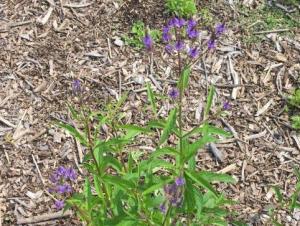

As summer approaches, let’s take a look at two of the bright flowers planted at the Field Station as habitat enhancements: blue vervain (Verbena hastata) and cardinal flower (Lobelia cardinalis). Both attract pollinators with their vibrant tube-shaped flowers. They are both commonly found in wet areas or along waterways, and though the parent plants are short-lived perennials, they readily self-seed.
Blue vervain, also known as blue verbena or swamp verbena, grows well in meadows or wetlands. In late summer, it blooms with a ring of small tube-shaped blue or purple flowers in flower spikes arranged like a candelabra, blooming from the bottom of each inflorescence upward. The flowers attract bees, wasps, flies, and butterflies and the seeds are eaten by songbirds such as cardinals, sparrows, and juncos. It is the larval host for the Common Buckeye butterfly (Junonia coenia). Blue vervain and its European cousin vervain (Verbena officinalis) have been used medicinally for a variety of purposes in traditional medicine, although blue vervain does interfere with some Western medicines like blood pressure medication and hormone treatments so it should be treated with caution. Blue vervain is a good addition to pollinator and rain gardens and is a native replacement for invasive plants like purple loosestrife (Lythrum salicaria), European wand loosestrife (Lythrum virgatum), and purple foxglove (Digitalis purpurea).
Cardinal flower is a bright red flower that grows in wetlands, wet meadows and woods, and areas along the water’s edge. A single flower spike that may be several feet tall blooms from the bottom up. Each flower is trumpet-shaped with two upper petals and three fused lower petals. The bright red color is attractive to hummingbirds and some butterflies, and the plant relies mainly on the ruby-throated hummingbird (Archilochus colubris) for pollination. The stamens are fused into a tube above the flower opening, and when a hummingbird visits the flower, the stamens brush on the bird’s forehead. The shape of the flower is difficult to navigate for most insect pollinators, but some bees steal nectar by perforating the lower part of the flower. Cardinal flower is toxic to humans and can cause contact dermatitis, but despite this it has been used medicinally by Native Americans. Over-picking and habitat loss have led to cardinal flower being listed as an “exploitably vulnerable native plant” in New York. This means that it is prohibited to pick, damage, or remove cardinal flower from private property or state-owned land (without permission of the owner). Cardinal flower is a lovely addition to pollinator and rain gardens and is a native replacement for aggressive plants like Canna lilies, Crocosmia, and Gladiolus, some cultivars of which can be invasive under certain conditions.
As you’re planning your gardens this summer, consider planting native plants like blue vervain and cardinal flower to attract pollinators when they bloom later this summer.
Image caption: Blue vervain planted at the GLC Field Station in the habitat enhancement gardens.
Some content on this page is saved in PDF format. To view these files, download Adobe Acrobat Reader free. If you are having trouble reading a document, request an accessible copy of the PDF or Word Document.
